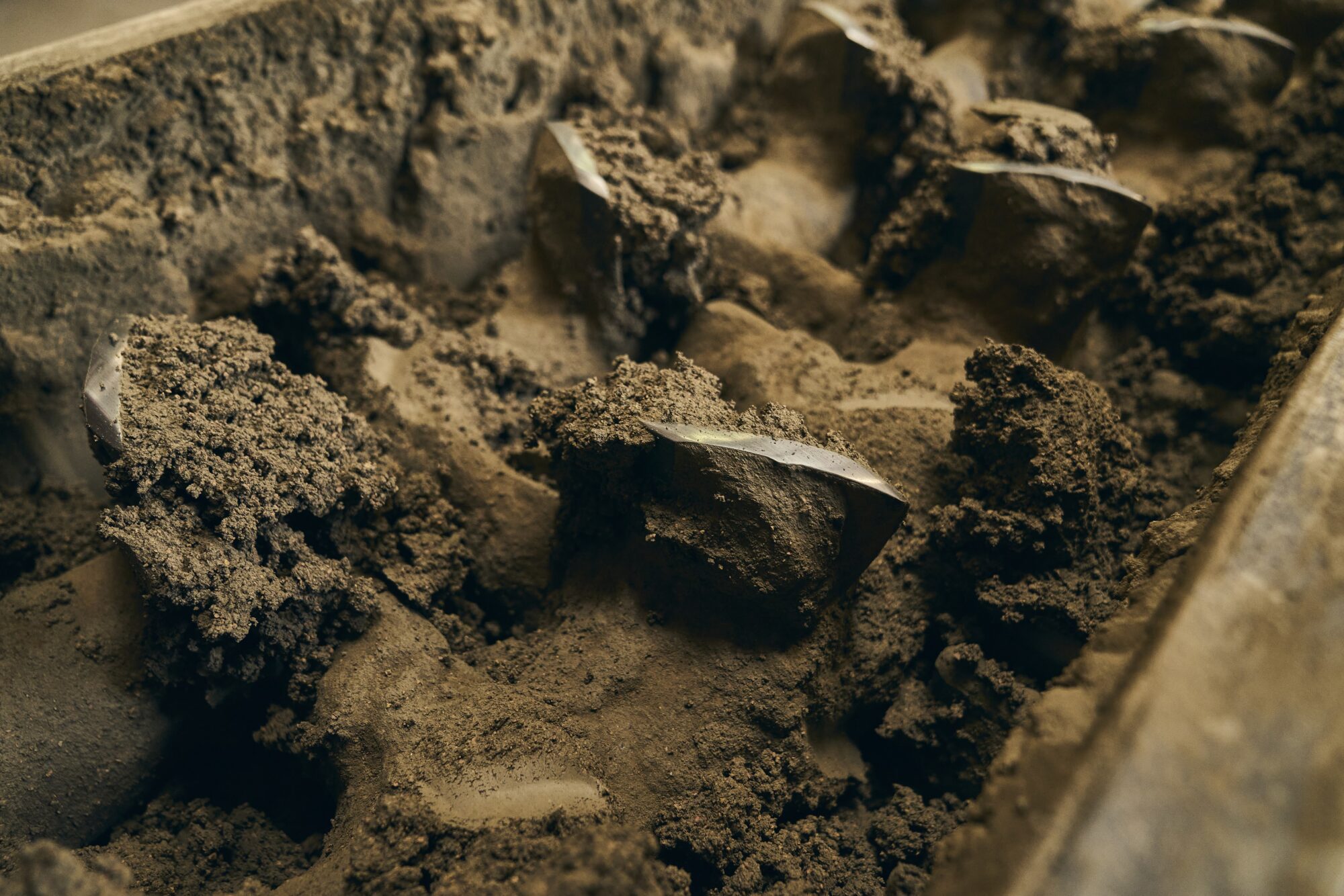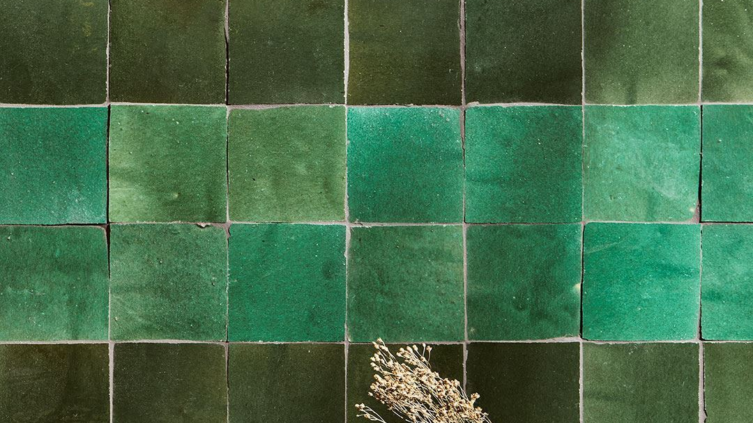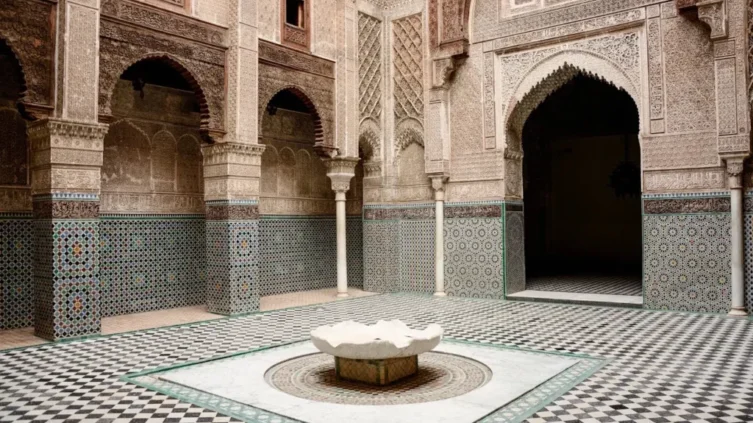Zellige tiles are well-known for their beautiful patterns and detailed craftsmanship. These tiles, which come from Morocco, are made from a special type of terracotta clay found in the Atlas Mountains. They are cut by hand and arranged to create unique geometric designs that are both strong and attractive.
The clay used for Zellige tiles has high amounts of silica (SiO₂) and alumina (Al₂O₃). Silica gives the tiles their strength, while alumina makes them stable. This clay also has minerals that create the bright colors and smooth surfaces that make Zellige tiles stand out from other ceramic tiles.
Making Zellige tiles involves both traditional skills and careful scientific methods. The main ingredients include silica for strength, alumina for stability, and different fluxes that help in the glazing process. Natural oxides are used to add various colors. This mix of components not only makes the tiles look good but also makes them durable and resistant to different environmental conditions.
Zellige tiles components have many benefits. Their high silica content makes them very durable, suitable for both indoor and outdoor use. The fine particles in the clay give them a smooth texture, and the unique minerals create a wide range of bright colors, making them versatile for design purposes. They absorb very little water and have high breaking strength, which means they are robust. They also resist scratches and chemicals, making them practical for many settings.
Research supports the quality of Zellige tiles. Studies show that their low water absorption helps maintain their structure in humid areas. Their high breaking strength means they can handle heavy use, making them great for busy areas. Their resistance to scratches and chemicals makes them long-lasting and easy to care for.
… The impact of sintering temperatures ranging from 900 to 1100 °C on parameters such as bulk density, porosity, water absorption, shrinkage, flexural strength, and chemical resistance was investigated. Results revealed elevated levels of Fe2O3 (>3 %), indicative of dark firing clays across all samples ….
“Evaluation and application of Moroccan clay materials in ceramic tiles: Composition and technological behavior”, Open Ceramics, Volume 18, 2024, Youssef Arkame, Achraf Harrati, Ayoub Imgirne, Aboubakar Moustapha, Yassine Et-Tayea, Imane Yamari, Ali Sdiri, Abdeslam El Bouari, Chaouki Sadik.
This article will explore the details of Zellige tiles, starting with the terracotta clay from the Atlas Mountains. It will cover the chemical makeup of the tiles, compare Zellige clay with other clays, and discuss their physical properties like water absorption, breaking strength, scratch hardness, and chemical resistance. We will also look at how Zellige tiles are made and their decorative uses, and finish with methods for preserving and restoring these tiles. This detailed look will explain the science and art behind Zellige tiles and their lasting appeal and usefulness today.
Geological Formation and Properties of Atlas Mountain Clay
The Atlas Mountains, a prominent mountain range in North Africa, provide a rich source of terracotta clay used in the production of Zellige tiles. This clay, known for its unique composition and exceptional qualities, is formed through complex geological processes over millions of years. Understanding the geological formation and properties of this clay is essential to appreciating its significance in Zellige tile production.
Geological Formation
The geological history of the Atlas Mountains spans several hundred million years, involving a series of tectonic events, sedimentary processes, and metamorphic transformations. The clay deposits in the Atlas Mountains primarily originate from the erosion of ancient rocks and subsequent sedimentation. Over time, these sediments were buried, compacted, and chemically altered, resulting in the formation of clay minerals.
The primary clay minerals found in the Atlas Mountain clay include illite, kaolinite, and smectite.
- Tectonic Activity: The formation of the Atlas Mountains is linked to the collision between the African and Eurasian tectonic plates. This collision, occurring approximately 80 million years ago, led to the uplift of the mountain range and the exposure of various rock formations to weathering and erosion.
- Erosion and Sedimentation: The intense weathering of exposed rocks, primarily granites and schists, produced fine particles that were transported by rivers and deposited in basins. These sediments gradually accumulated, forming thick layers of clay-rich deposits.
- Diagenesis: Over millions of years, the accumulated sediments underwent diagenesis, a process involving the compaction and cementation of sediments, along with chemical alterations. Diagenesis transforms the original minerals into stable clay minerals like illite, kaolinite, and smectite.
Properties of Atlas Mountain Clay
The unique properties of Atlas Mountain clay make it highly suitable for Zellige tile production.
These properties include its mineralogical composition, particle size distribution, plasticity, and firing characteristics.
- Mineralogical Composition: Atlas Mountain clay is rich in silica (SiO₂) and alumina (Al₂O₃), with typical concentrations ranging from 40% to 50% for silica and 15% to 25% for alumina. The clay also contains varying amounts of iron oxide (Fe₂O₃), calcium oxide (CaO), and potassium oxide (K₂O), contributing to its color and firing properties. For instance, the presence of iron oxide, typically around 5% to 10%, gives the clay its reddish hue when fired.
- Particle Size Distribution: The particle size distribution of Atlas Mountain clay is crucial for its plasticity and workability. The clay particles are generally fine, with a significant proportion less than 2 micrometers in diameter. This fine particle size ensures a smooth texture and high plasticity, making the clay easy to shape and mold.
- Plasticity: The plasticity of Atlas Mountain clay is a measure of its ability to be molded and retain its shape. High plasticity is essential for producing intricate Zellige tile patterns. The plasticity index of this clay typically ranges between 20 and 35, indicating excellent workability.
- Firing Characteristics: During the firing process, the mineral composition of the clay undergoes significant changes. The high silica and alumina content contribute to the formation of a robust ceramic matrix. The optimal firing temperature for Atlas Mountain clay ranges from 900°C to 1100°C. At these temperatures, the clay achieves its maximum hardness and durability, with a flexural strength ranging from 15 to 25 MPa and a low water absorption rate of less than 10%.
- Chemical Durability: The chemical composition of Atlas Mountain clay imparts excellent resistance to acids and alkalis. This property is particularly important for tiles used in kitchens and bathrooms, where exposure to various chemicals is common.
The geological formation of Atlas Mountain clay involves a series of complex processes that result in a material with unique and desirable properties for Zellige tile production. Its rich mineralogical composition, fine particle size, high plasticity, optimal firing characteristics, and chemical durability make it an ideal choice for creating beautiful and durable Zellige tiles.
Chemical Cocktail: The Science Behind Zellige’s Composition
The unique and enduring qualities of Zellige tiles are the result of a careful blend of various chemical components. Understanding the science behind their composition reveals why these tiles are celebrated for their durability, vibrant colors, and intricate patterns. The primary elements that constitute Zellige tiles include silica, alumina, fluxes, and oxides.
Silica (SiO₂) – The Backbone of the Tile
Silica (SiO₂) is a critical component in the production of Zellige tiles, serving as the structural backbone. This mineral is primarily derived from quartz, which is abundant in the Atlas Mountain clay. The high silica content, typically ranging from 40% to 50%, provides several essential properties:
- Strength: Silica imparts significant mechanical strength to the tiles, allowing them to withstand considerable pressure and impact without breaking.
- Durability: High silica content ensures the tiles are long-lasting and resistant to wear and tear, making them suitable for high-traffic areas.
- Thermal Stability: Silica contributes to the thermal stability of Zellige tiles, enabling them to withstand high firing temperatures (900°C to 1100°C) without deforming.
Alumina (Al₂O₃) – Adding Strength and Stability
Alumina (Al₂O₃) is another vital component found in the Atlas Mountain clay, with typical concentrations ranging from 15% to 25%. Alumina enhances the structural integrity and overall performance of Zellige tiles in several ways:
- Hardness: Alumina increases the hardness of the tiles, making them resistant to scratching and surface wear.
- Stability: It improves the stability of the ceramic matrix during the firing process, reducing the likelihood of warping or cracking.
- Heat Resistance: Alumina contributes to the tiles’ ability to endure high temperatures, which is crucial for maintaining their shape and integrity during and after firing.
Flux – Facilitating the Glazing Process
Fluxes play a crucial role in the production of Zellige tiles by lowering the melting point of the clay during firing, which facilitates the glazing process. Fluxes ensure that the glaze bonds properly to the tile surface, creating a smooth, glossy finish.
Common Fluxes Used in Zellige Production
- Potassium Oxide (K₂O): Found in feldspar minerals, potassium oxide is a common flux that helps in lowering the melting point and promoting the formation of a glassy phase.
- Sodium Oxide (Na₂O): Derived from soda ash and feldspars, sodium oxide also acts as a flux, enhancing the fluidity of the glaze and contributing to a smooth surface finish.
- Calcium Oxide (CaO): Often sourced from limestone, calcium oxide serves as a flux that aids in the vitrification process, increasing the hardness and durability of the tiles.
Oxides – Introducing Color and Character
Oxides are responsible for the rich and varied colors that make Zellige tiles so distinctive. These natural oxides are carefully selected and blended to achieve the traditional hues seen in Zellige art.
Natural Oxides for Traditional Zellige Colors
- Iron Oxide (Fe₂O₃): Iron oxide imparts a range of colors from deep reds to warm yellows, depending on its concentration and the firing conditions. Typically, iron oxide content in Zellige tiles ranges from 5% to 10%.
- Copper Oxide (CuO): Used to create vibrant greens, copper oxide is a key component in achieving the striking green glazes characteristic of many traditional Zellige designs.
- Cobalt Oxide (CoO): Cobalt oxide is employed to produce rich blue tones, which are highly prized in Zellige mosaics.
- Manganese Oxide (MnO₂): This oxide contributes to dark brown and black hues, adding depth and contrast to the tile patterns.
The composition of Zellige tiles is a sophisticated blend of silica, alumina, fluxes, and oxides. Each component plays a specific role in enhancing the tiles’ structural integrity, aesthetic appeal, and durability. This chemical cocktail is what gives Zellige tiles their unique characteristics and enduring popularity in both traditional and contemporary designs.
Distinctive Traits: How Zellige Clay Differs
Zellige clay, sourced from the Atlas Mountains, stands out from other types of clay due to its unique composition and properties. These distinctive traits are crucial for the production of high-quality Zellige tiles.
-
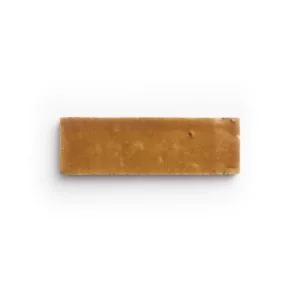 Zellige Tabac 2 x 6$92.06
Zellige Tabac 2 x 6$92.06 -
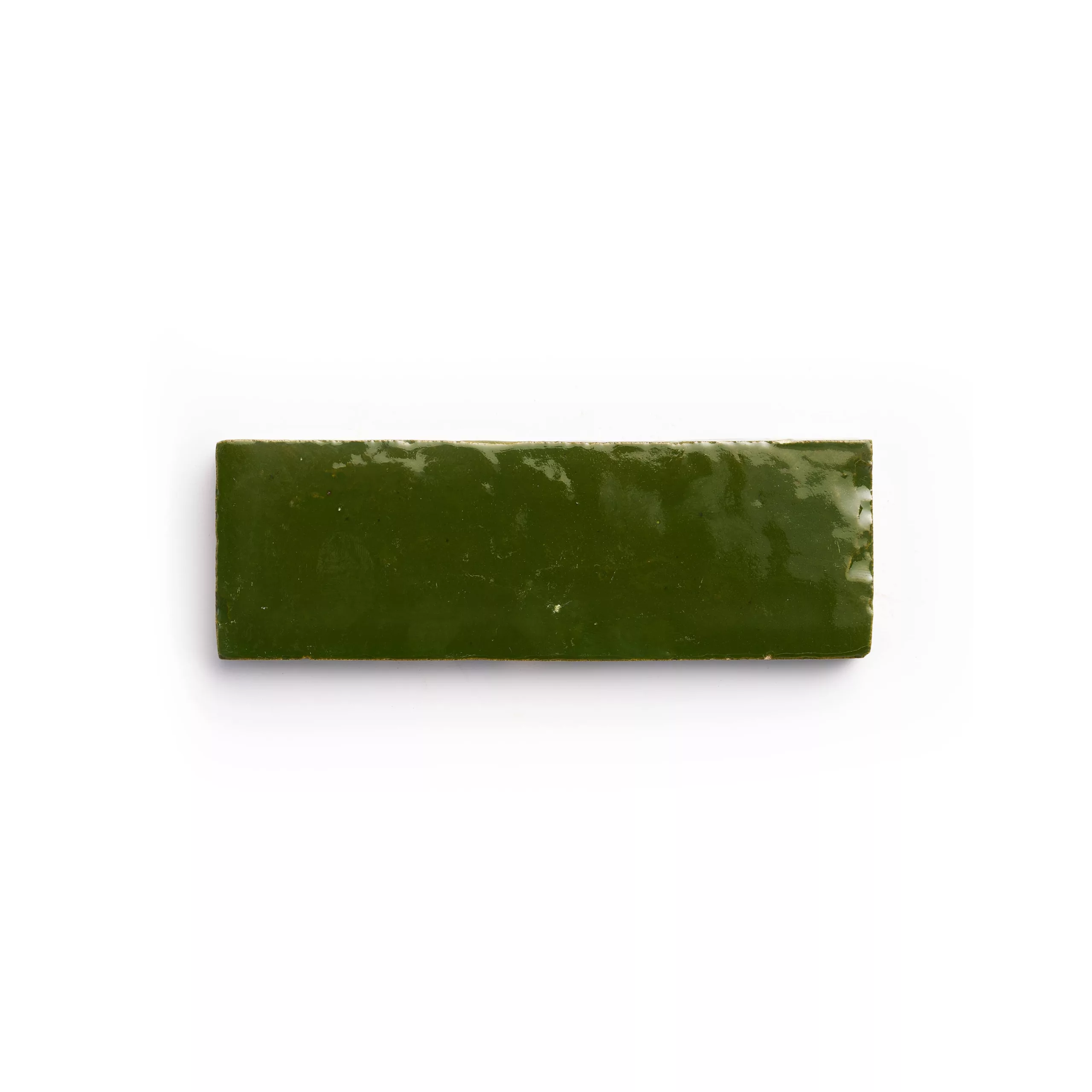 Zellige Vert Imperial 2 x 6$92.06
Zellige Vert Imperial 2 x 6$92.06
Higher Silica Content for Enhanced Durability
Zellige clay contains a higher percentage of silica compared to red earthenware clay, typically ranging from 40% to 50%. This higher silica content provides several benefits:
- Enhanced Strength: Higher silica levels increase the mechanical strength of the tiles, allowing them to withstand significant pressure and impact.
- Increased Durability: Silica contributes to the tiles’ longevity, making them suitable for both indoor and outdoor applications.
Finer Particle Size for Smooth Textures
The particle size of Zellige clay is generally finer than that of red earthenware clay. The fine particle size, often less than 2 micrometers in diameter, offers:
- Smooth Texture: The finer particles create a smoother surface, essential for the intricate patterns characteristic of Zellige tiles.
- Better Workability: Finer particles enhance the clay’s plasticity, making it easier to shape and mold into detailed designs.
Unique Mineral Composition for Vibrant Colors
Zellige clay’s mineral composition includes a mix of quartz, feldspar, and various oxides. This unique blend results in:
- Vibrant Colors: The presence of natural oxides, such as iron, copper, and cobalt, allows for a wide range of vibrant colors in Zellige tiles.
- Consistent Firing Results: The specific mineral content ensures consistent color and quality when the tiles are fired at high temperatures.
Impact of Clay Composition on Zellige Production Techniques
The unique composition of Zellige clay significantly influences its production techniques, including:
- Traditional Craftsmanship: The high plasticity and fine texture of Zellige clay enable artisans to create intricate and precise designs.
- Glazing and Firing: The clay’s mineral content ensures that the glaze bonds effectively during the firing process, resulting in a durable and aesthetically pleasing finish.
- Durability and Maintenance: The chemical composition of Zellige clay contributes to the tiles’ resistance to water absorption, scratching, and chemical exposure, making them easy to maintain and highly durable.
Zellige clay differs significantly from other clays, particularly red earthenware clay, in terms of silica content, particle size, mineral composition, and its impact on production techniques. These distinctive traits contribute to the exceptional quality and enduring appeal of Zellige tiles.
Evaluation of Moroccan Clay Materials
Moroccan clay materials, particularly those sourced from regions such as Fez-Meknes, Safi, Berrechid, and Benslimane, have been extensively studied for their suitability in ceramic tile production. These clays exhibit unique chemical and mineralogical characteristics that make them ideal for creating high-quality ceramics.
Thermal Behavior and Sintering Process
The thermal behavior of Moroccan clays is crucial for determining their suitability in ceramic manufacturing. Sintering temperature significantly affects the properties of the final ceramic product.
Impact of Sintering Temperature on Properties
Moroccan clays are typically sintered at temperatures ranging from 900°C to 1100°C. The effects of sintering at these temperatures include:
- Bulk Density: Increases with higher sintering temperatures, indicating better compaction and fewer voids.
- Porosity: Decreases as sintering temperature rises, resulting in a denser and more durable ceramic.
- Water Absorption: Lower at higher sintering temperatures, enhancing the durability and suitability for use in moist environments.
Formation of New Phases during Sintering
During the sintering process, new crystalline phases form, contributing to the material’s final properties:
- Gehlenite (Ca₂Al₂SiO₇): Forms from the reaction between silica, alumina, and calcium oxide, enhancing the mechanical properties of the ceramic.
- Anorthite (CaAl₂Si₂O₈): Develops at higher temperatures, contributing to the tile’s durability and structural integrity.
Physical and Mechanical Properties
The physical and mechanical properties of ceramics produced from Moroccan clays are critical indicators of their quality and suitability for various applications.
Bulk Density, Porosity, and Water Absorption
The physical properties of ceramics made from Moroccan clays are measured by their bulk density, porosity, and water absorption:
- Bulk Density: Typically increases with higher sintering temperatures, indicating improved material compaction.
- Porosity: Lower porosity at higher temperatures results in a denser material, enhancing its strength and durability.
- Water Absorption: Reduced water absorption rates are essential for maintaining structural integrity in wet environments.
Flexural Strength and Dimensional Stability
The mechanical properties of ceramics are assessed through flexural strength and dimensional stability:
- Flexural Strength: Values range from 15 to 25 MPa, with higher strengths achieved at elevated sintering temperatures. This property is crucial for the tile’s ability to withstand mechanical stress.
- Dimensional Stability: Low shrinkage rates ensure that the tiles maintain their shape and size during firing, reducing defects and improving overall quality.
Chemical Resistance
Chemical resistance is a vital property for ceramics used in various environments, particularly those exposed to harsh chemicals.
Resistance to Acidic and Alkaline Environments
Moroccan clays demonstrate excellent resistance to both acidic and alkaline conditions, making them suitable for a wide range of applications:
- Acidic Resistance: The ceramics exhibit minimal mass loss when exposed to acidic conditions, ensuring longevity and durability.
- Alkaline Resistance: Similarly, they show strong resistance to alkaline environments, maintaining their structural integrity and appearance over time.
In summary, the evaluation of Moroccan clay materials highlights their high silica and alumina content, beneficial mineralogical composition, favorable thermal behavior, robust physical and mechanical properties, and excellent chemical resistance. These characteristics make them ideal for producing high-quality Zellige tiles and other ceramic products.
Physical Attributes of Zellige
Water Absorption: A Measure of Porosity
Water absorption is a critical measure of the porosity of Zellige tiles. This attribute significantly affects their durability and suitability for various applications.
Ideal Water Absorption Range for Zellige
Zellige tiles are characterized by their low water absorption rates, typically ranging between 3% and 6%. This low porosity is essential for several reasons:
- Durability: Lower water absorption means the tiles are less likely to crack or break under freeze-thaw cycles, enhancing their longevity.
- Moisture Resistance: Low porosity makes Zellige tiles suitable for humid environments, as they absorb less water and resist mold and mildew growth.
Impact of Water Absorption on Performance and Applications
The water absorption rate of Zellige tiles directly influences their performance and the types of applications they are best suited for:
- Indoor Applications: Tiles with low water absorption are ideal for bathrooms, kitchens, and other areas exposed to moisture.
- Outdoor Applications: These tiles are also suitable for outdoor use, as their low porosity helps them withstand weathering and environmental stress.
Breaking Strength: Resisting Pressure and Impact
Breaking strength is a measure of a tile’s ability to resist pressure and impact without cracking or breaking. This attribute is vital for ensuring the tile’s performance in high-traffic areas.
Factors Influencing Breaking Strength of Zellige
Several factors contribute to the breaking strength of Zellige tiles:
- Clay Composition: The high silica and alumina content in Zellige clay enhances the mechanical strength of the tiles.
- Firing Process: Proper sintering at temperatures between 900°C and 1100°C helps achieve optimal breaking strength by forming a robust ceramic matrix.
- Tile Thickness: Thicker tiles generally have higher breaking strength, providing greater resistance to mechanical stress.
Comparison of Breaking Strength with Other Tiles
Zellige tiles exhibit superior breaking strength compared to many other types of ceramic tiles:
- Traditional Ceramic Tiles: Zellige tiles often surpass traditional ceramic tiles in breaking strength due to their unique clay composition and manufacturing process.
- Porcelain Tiles: While porcelain tiles are known for their high strength, Zellige tiles offer comparable breaking strength with the added benefit of unique aesthetic qualities.
Scratch Hardness: Maintaining Surface Integrity
Scratch hardness is a measure of a tile’s resistance to surface scratches and abrasions. Maintaining surface integrity is crucial for the longevity and aesthetic appeal of Zellige tiles.
Mohs Scale of Hardness and Zellige’s Rating
The Mohs scale of hardness is used to rate the scratch resistance of minerals and materials:
- Zellige Tiles: Typically rate around 5 to 6 on the Mohs scale, indicating good resistance to scratching and wear.
- Comparison: This rating is comparable to other high-quality ceramic tiles, ensuring that Zellige tiles maintain their surface integrity under normal use.
Strategies for Enhancing Scratch Resistance
Several strategies can be employed to enhance the scratch resistance of Zellige tiles:
- Glazing Techniques: Applying a durable glaze can significantly improve scratch resistance by creating a harder surface layer.
- Proper Maintenance: Regular cleaning and avoiding abrasive cleaning agents can help maintain the scratch resistance of the tiles.
Chemical Resistance: Withstanding Environmental Challenges
Chemical resistance is a critical attribute for Zellige tiles, determining their ability to withstand exposure to various chemicals without deteriorating.
Resistance to Acids, Alkalis, and Stains
Zellige tiles demonstrate excellent resistance to a range of chemicals, making them suitable for both residential and commercial applications:
- Acid Resistance: The tiles resist corrosion and staining from acidic substances, making them ideal for kitchens and bathrooms.
- Alkali Resistance: They also withstand exposure to alkaline substances, ensuring longevity in various environments.
- Stain Resistance: The tiles’ low porosity and durable glaze help prevent staining from common household substances.
Suitability for Different Indoor and Outdoor Applications
The chemical resistance of Zellige tiles makes them versatile and suitable for a variety of applications:
- Indoor: Perfect for areas exposed to food spills, cleaning agents, and moisture, such as kitchens, bathrooms, and living spaces.
- Outdoor: Suitable for outdoor installations, including patios and garden paths, where they may be exposed to environmental pollutants and weathering.
The physical attributes of Zellige tiles, including water absorption, breaking strength, scratch hardness, and chemical resistance, make them a superior choice for a wide range of applications. Their unique composition and manufacturing process ensure durability, aesthetic appeal, and long-term performance.
-
 Zellige Tabac 2 x 6$92.06
Zellige Tabac 2 x 6$92.06 -
 Zellige Vert Imperial 2 x 6$92.06
Zellige Vert Imperial 2 x 6$92.06
